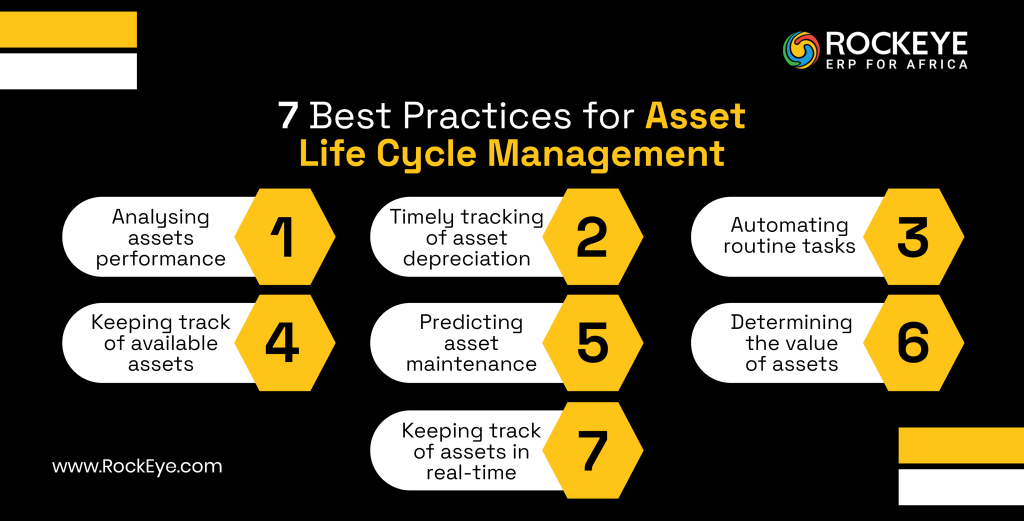Understanding Asset Life Cycle and Best Practices for Asset Life Cycle Management
Most organisations consider asset management a top priority because assets drive business. They are the lifeblood of businesses and all over the world. Thus, enterprises invest so much dollars in asset management.
Since asset management is the core part of a business, companies rely on assets to drive sales and sustain their business. But is asset management an easy feat? Absolutely not.
Asset management isn’t a novel idea; it has existed for decades, but it is one domain that constantly evolves and is challenging to manage. To stay on top of asset management, business owners saw the need for a strategy which would not only help them stay in control of their asset management but also help them maintain the entire life cycle of their asset and ensure its longevity.
The simple strategy businesses employ is incorporating technology into asset management, especially intelligent solutions. With this one move, small businesses have grown into global organisations, and top organisations have managed their diverse assets from one centralised system: Asset Management Solution System.
Let’s look deeper into this concept and others tied to it.
What is Asset Management?
Consider this scenario: Michael, a business owner with a lot on his desk, realises he needs to acquire more assets for his daily operations. Firstly, he maps out a plan to help him ensure he purchases the best assets for his business. But his work is still far from being done because asset management doesn’t end with acquiring the assets.
Once he acquires the assets, he must also ensure that they perform to their optimal capacity by carrying out constant maintenance checks on them. That is because assets can have more downtimes than uptimes without a proper maintenance plan or regular inspections.
When an asset is neglected or not properly managed, its lifespan reduces. The lifespan depreciation leads to more downtimes, costly repairs and production delays. It could also be a potential source of danger to employees if not handled immediately.
In summary, asset management is all about creating a plan that helps determine the types of assets to acquire and how to maintain them. It involves developing a plan, controlling the acquisition process, operating the assets and maintaining them throughout their lifecycle.
Asset management is a critical aspect of any business, and many enterprises leverage asset management software solutions to streamline their asset maintenance process and ensure the longevity of the assets.
Understanding Asset Life Cycle?
The asset life cycle is the different stages a company’s asset goes through during its ownership. Every asset goes through four stages in its lifecycle: the acquisition stage, operational stage, maintenance, and the renewable or disposable stage.
An asset life cycle begins with a need for an asset and continues through the maintenance and renewable or disposal stage. An asset with a healthy life cycle increases efficiency and reduces downtime, and when an asset is efficiently managed, its life cycle extends. That is why businesses invest heavily in asset management solutions to ensure that they work optimally and that their life cycle is prolonged, reducing the need to dispose of or replace the parts.
Suppose you experience more downtimes than uptimes with your assets and feel like you are drowning in a sea of bills incurred by constant asset maintenance and repairs. In that case, you need to level up and switch from manual asset management to deploying asset management software solutions.
Given the importance of assets, many organizations have transitioned from manual asset management to a more efficient and seamless method using asset management solutions.
What is an Asset Management Solution
According to Technopedia, an asset management solution or software is a technological tool that keeps track of an asset’s entire lifecycle. It plays a vital role in asset life cycle management.
This solution helps businesses keep a record of and track their assets; it carries out predictive maintenance checks and ensures that businesses comply with regulations.
Apart from those great benefits, asset management solutions also assess depreciation and help business owners gain insights into the value and costs of replacements or upgrades, enhancing informed decision-making instead of relying on guesswork.
According to Statista, the global market for fixed asset management software has been estimated to go from 3 billion U.S. dollars in 2019 to 5.2 billion U.S. dollars in 2024. Asset management solutions enhance productivity and help to streamline maintenance processes. Hence, businesses that leverage asset management solutions get the value of their investments and are empowered to have a bird’s-view of their assets remotely, unlike those who don’t.
What best practices should business owners adopt for their life cycle management?

Analysing assets performance
This is a crucial aspect of asset management, and if neglected, the expected outcome would be experiencing massive downtimes. One of the pitfalls of humans is that they can forget things, but computers don’t. With an asset management system, you can detect and prevent errors before they occur, helping you optimise your assets’ performance. In addition, timely asset performance analysis helps reduce downtimes and increases profitability and efficiency.
Timely tracking of asset depreciation
Each time you use any of your assets, its value decreases, and with continuous usage and other factors such as poor maintenance or exposure to weather elements, it depreciates. Therefore, it is essential to re-evaluate your assets, but manually doing this makes the process difficult. With an asset management solution, you can automate this process and keep track of your assets throughout their lifecycle. As a result, you’ll be able to make well-informed and data-backed decisions about your assets.
Automating routine tasks
Automation is one powerful benefit of asset management solutions. Every little but time-consuming task can be automated, and while you are busy with other operations, these tasks will be performed automatically. So, the asset management solution system can schedule and notify you of upcoming asset maintenance and automate several processes involved in asset management, ensuring that your workflow is not interrupted.
Keeping track of available assets
Imagine your grandfather leaving you an inheritance in his will, but sadly, he didn’t remember where the property is. So, you have a multi-million property on paper but don’t know where it is.
This definitely wouldn’t be a good feeling, and the same applies to business owners who cannot keep track of all their assets. Sometimes, an asset’s lifecycle is cut short because the owner doesn’t remember they have such an asset, and as a result, the asset is left unused, neglected, and its value left unharnessed.
However, this challenge can be overcome with an asset management solution. The system centralises all the information about your assets in one place; keeping track of each asset and its life cycle is easier, ensuring that they all function optimally.
Predicting asset maintenance
This is a core aspect of asset life cycle management, and it requires proper planning; if not, it can drastically reduce your asset’s lifespan.
The good thing is that asset management solutions can perform advanced checks and predict faults and impending failures. This helps you to take quick action before the situation worsens.
In addition, an asset management solution provides data analytics that helps you take a more proactive approach to sustaining your assets’ life cycle and invariably prevent a looming downtime.
Determining the value of assets
Using an asset management solution helps you determine the value of your assets by providing you with the data of an asset’s performance. This would give you an inference on whether or not to invest more in that asset.
In addition, an asset management solution helps you determine how well an asset serves you and if that asset has been able to help you meet your objectives. Constantly determining the value of your assets is a best practice that will strengthen the reins of your fleet management endeavours.
Keeping track of assets in real-time
If you want your assets to last longer, it is better to track them in real-time. Technology is the only way to track an asset’s real-time performance. You guessed right—an asset management solution. You cannot be everywhere at the same time, but it is possible to be everywhere at the same time when you leverage asset management solutions. With this, you can keep track of your assets in real-time while on the go or remotely. Your asset management team doesn’t have to be on-site to know how an asset performs. All they have to do is look at the asset management solution dashboard, and they can get all the information they need.
Taking these asset management best practices into good use will be a deal-breaker for your business.
But there’s something else you should know.
Conclusion
The best practices for asset life cycle management can be seamless when you leverage asset management solutions. You can easily have a 360 view of all your available assets, keep track of your assets in time in real-time and access them remotely.
At RockEye, we understand the pain points associated with asset life cycle management. Let us help you overcome all asset management challenges to increase your business’s profitability and operational efficiency.
Send an email to [email protected] to get more information.


